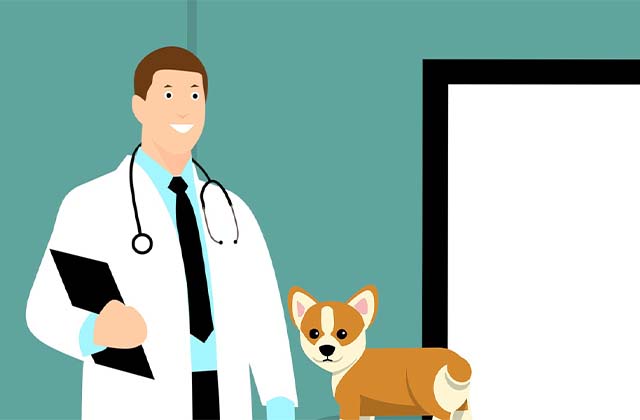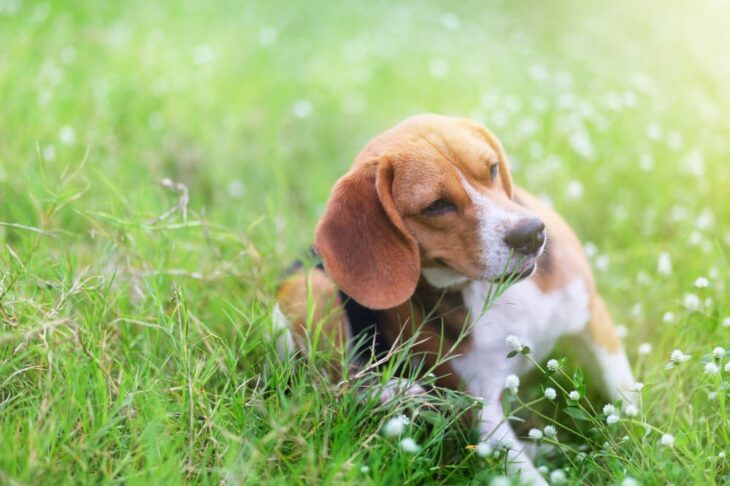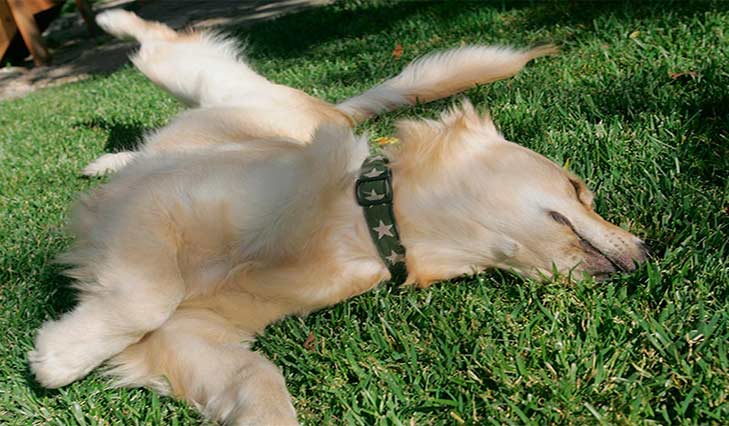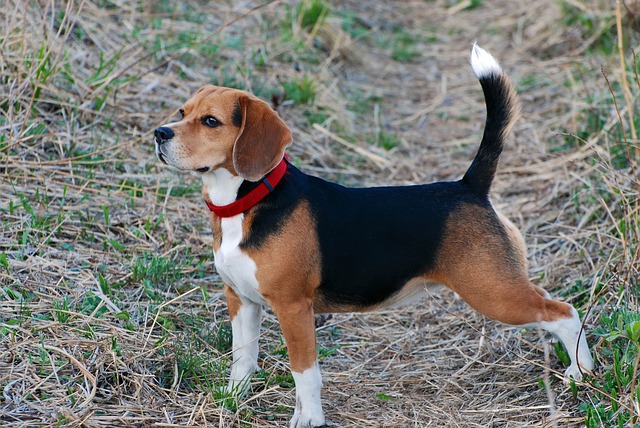
Why Does My Dog Wag Her Tail While Sleeping? 11 Common Reasons & Is It Normal
First, why does my dog wag her tail while sleeping?
Because they are in a deep sleep, dogs wag their tails while they are sleeping. They undergo what is known as “Rapid Eye Movement” (REM) during their deepest stages of sleep, just like we do. Dreams take place during REM sleep, and dogs are not all that different from us in terms of our own evolutionary developments.
Therefore, researchers have come to the conclusion that just like humans, dogs also experience dreaming during this stage of deepest sleep.
Please continue reading as I provide more detailed information about why my dog wags her tail while sleeping.
Table of Contents
Why Does My Dog Wag Her Tail While Sleeping?
Even though your dog appears to be dozing off, its tail is still wagging. You might wonder what’s going through their minds as a result. Why do they wag their tails while they are asleep?
Dog’s Confidence Is Showing
Confidence can either be a positive trait or a recipe for disaster. But generally speaking, dreaming is a good thing.
Your dog might start wagging its tail when they feel confident in a dream or when they feel confident in general. For instance, if they are certain they will catch the ball they are dreaming of.
Having A Happy Dream
One of the main explanations for why your pet’s tail wags while they sleep is that they had a pleasant dream that made them joyful enough to do so.
Your dog may act as though running while enjoying a pleasant dream. If they are having a particularly enjoyable dream, they might even quietly bark or make happy noises.
You don’t need to be concerned or wake them up too soon in this situation.
Allow your dog to dream and wait for them to wake up when they are rested.
Expressing Contentment While Asleep
When your dog is completely satisfied, it may occasionally wag their tails while they are sleeping. Their tail may begin to wag unintentionally whether they are sleeping on their bed or in their preferred position curled up next to you. Your dog’s tail might wag briefly or gradually before ceasing to do so.
Experiencing Cold Or Shivering
Your dog may be cold if you see that his tail is wagging and he is shaking or trembling otherwise. This might occur in an air-conditioned space or if the temperature drops suddenly. Make sure your dog has enough heat.
Cover your dog with a blanket or two if you think they might be cold so they can regulate its body temperature better.
Having A Nightmare
A dog’s tail wagging while it is sleeping, which is frequently a sign of excitement or happiness, could also indicate that the animal is having a nightmare.
If your dog is slowly wagging its tail and barking, whining, or making other sounds that typically indicate distress, be cautious about waking them.
But if you’re going to wake your dog, remember a few things. It’s possible that your dog is lost or confused. When your dog is having a nightmare, avoid shaking or petting him. If you do it, there’s a chance the dog will start barking.
Instead, gently call your dog’s name over and over until they begin to slowly wake up from their nightmare.
As this may frighten them even more, refrain from yelling at them or speaking in a nervous tone of voice.
When your dog is alert, give them a treat or their preferred toy to help them relax.
Submission May Cause “sleep Wagging”
While they may not like to admit it to themselves, dogs are typically submissive to their owners, and their body language will reflect this. A dog’s tail frequently wags when it is submissive. They might unintentionally act submissive when they are dreaming about you.
Having A Seizure
Rarely, a sleeping dog who wags its tail may be having a seizure. Because seizure movements can resemble sleep movements, this can be difficult to identify.
During a seizure, your dog’s body may appear rigid. It’s easy to experience fear and panic because seizures are terrifying to watch. Instead, maintain your composure because your dog might require help.
If your dog is convulsing and is lying in an elevated position, try to support their head with a soft towel and prevent them from falling.
When they are having a seizure, stay away from their mouths and don’t stick your hand in there. You might get bitten by your dog as a result of that, or you might end up choking someone.
Keep your dog calm if they become disoriented during the seizure and wait for it to end.
Take your dog to the vet right away if this is your dog’s first seizure. To rule out potential conditions and determine the underlying cause, your veterinarian may perform a few tests on your pet.
Your dog’s veterinarian might recommend anti-seizure medications to stop further seizures. Give your dog the medication religiously if that occurs to prevent any subsequent incidents.
Dreaming
Because they are dreaming, dogs wag their tails while they are sleeping. It is believed that dogs dream similarly to people. Of course, it’s challenging to pinpoint the details of what occurs when dogs dream. Humans can talk about their dreams after waking up, but you can’t ask your dog what they were thinking about.
Dreaming happens during REM sleep. In essence, during sleep, brain pathways are activated, paralyzing the body to prevent movement. Because of this, neither you nor your dog get out of bed to run when you do so in your dreams.
This mechanism is imperfect in both humans and dogs. Movements do occur occasionally. The most likely cause of your dog’s tail wagging while they sleep is a dream-related event.
Anxiety Or Fear
Even though his tail may be wagging, if your dog is holding his tail lowered and in between his legs, he probably isn’t feeling very comfortable.
Depending on the situation or other cues from his body language, such as pricked ears or tense positioning, he may be fearful or anxious.
Generally speaking, a slow tail wag does not indicate a happy dog. Instead, he might be conveying submission or fear. He might also be regretting ruining your favorite pair of slippers.
Try to reassure your dog and let him know he’s okay, even if he’s done something wrong, if you notice a slow-moving tail.
Remember that if your tone is overtly angry or frustrated, your dog will pick up on it and his tail will wag in return, whether it’s your favorite pair of shoes or the couch cushions he’s destroyed.
It’s important to remember that dogs don’t deliberately set out to chew on your priceless possessions; instead, they are acting instinctively and need to be taught the difference between their toys and yours.
In light of this, it’s best to avoid making your dog feel scared or anxious as a result of his undesirable behavior.
Curiosity And Attention
An unusually upright tail indicates that your dog is likely interested in something or is paying attention to it; he may be anticipating your toss of the ball. He is alert and paying close attention as he prepares to take action.
Some dogs have a special ability to identify objects or prey by pointing at them with their paws while simultaneously holding their tails up high, similar to how you might stand more upright when you are trying to listen intently or hear someone else speak.
These “pointer” dogs might behave in the same way while they’re asleep, particularly if they’ve been conditioned to do it when they’re awake during the day.
Happiness
The saying “wag more, bark less” is a well-known way of asking for everyone to be a little friendlier to one another. Usually a friendly greeting or an expression of excitement, a wagging tail swings vigorously.
His tail is moving swiftly from side to side and back again, as you can see. Even worse, he might begin circling in an attempt to pursue it. These are all indications that your dog is content and happy to see you.
Your Dog’s Tail Wag Indication: Sleep Quality
Your dog may be dreaming while they are sleeping if you can tell by the way their tail wags. But how can you tell if your dog is getting enough rest? You might assume that a dog’s tail is wagging when it is dozing off. But the reality is quite the opposite. Your dog is likely to be sleeping deeply if its tail is wagging. See more about Why Do Dogs Blow Out Their Nose?
Watch Your Dog’s “Sleep Wagging”
When your dog’s tail is wagging while they are sleeping, it is crucial to pay close attention. Typically, it is a sign that your dog is getting a restful night’s sleep. But regrettably, it might also be a sign of something more if it’s coupled with other behaviors.
What Must You Look Out For?
Twitching, also known as “sleep wagging,” may be an indication that your dog is experiencing sleep problems. Although it is uncommon, it is possible that this is the case. Sleep disorders that your dog might experience include narcolepsy, insomnia, and sleep apnea.
What Is Narcolepsy?
Low levels of a chemical that regulates alertness and sleep patterns are the cause of narcolepsy, which results in muscle paralysis. Other indications and symptoms are:
- a back that appears to be too relaxed or not straight.
- As if they were made of wood, their legs started to stiffen.
- Your dog toppling over or episodes of drowsiness that occur at random times
- exhibiting a lack of activity during the day or being overly tired.
Insomnia And Your Dog
Despite being uncommon, insomnia is a possibility. It is typically brought on by a physically uncomfortable illness. It can disrupt sleep and is more frequent in older dogs. Examine the following additional signs:
- before going to bed, pacing back and forth across the floor.
- Vocalization before going to sleep, such as howling, barking, grunting, whining, etc.
- They appear to be extremely hot by sticking out their tongue or panting.
Have Sleep Apnea Concerns?
Obese or elderly dogs are more likely to have sleep apnea. It is a temporary collapse of the airway that may cause your dog to struggle breathing, a sign being twitching of the tail. Indicators of sleep apnea include the following:
- frequently occurring loud snoring.
- an excessive amount of daytime fatigue.
- Grunting or generally vocalizing all through the night.
- throughout the day, easily irritated by everyone, including you.
- Attempting to breathe while gasping and choking.
Please take your dog to the vet if he or she exhibits these symptoms in addition to “sleep wagging.” These sleep disorders should not be taken lightly.
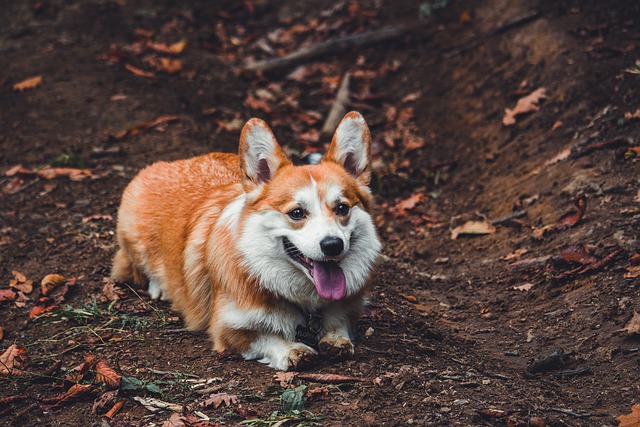
Is Wagging A Dog’s Tail While Sleeping Common?
A dog waving its tail while sleeping is perfectly normal. The only thing left to do is determine the cause and, if necessary, take the appropriate action. You can help them feel better, for instance, if they are having a nightmare.
Is shouting out while sleeping or sleepwalking normal in humans? Yes.
Being commonplace lets us know that it is normal.
Even though it’s odd, it’s a part of who we are.
Research has shown that dogs are incredibly similar to us with regards to dreaming.
Dogs acting like they’re dreaming while they sleep is thus completely normal. That includes when they wag their tails.
In addition to being normal, it also shows that your dog is getting a good night’s sleep.
Not all signs involve a wagging tail.
Your dog is in a deep sleep if it makes any movement at all.
And as we all know, a deep sleep is a good sleep.
‘What nonsense, exactly? The only dreamers are us humans!
Where is your supporting documentation?
Have you seen “Dog Dreams”?’
Scientists have long known that other animals dream.
They have conducted experiments on rats to ascertain this theory.
Given that dogs have much more developed and sophisticated brains than rats, if rats can dream, then dogs most certainly can as well.
Do Dogs Inadvertently Wag Their Tails?
Dogs are able to control their tail wagging. On occasion, though, they will unconsciously wag their tails.
Like an arm or a leg, a dog’s tail is a part of its body.
By that, I mean they have the same mental control over their tail as they do over other parts of their bodies.
Dogs willfully use their tails to help them balance more often.
Dogs do, in fact, unconsciously wag their tails as well.
A natural response to some sort of stimulus will cause this to happen.
People often make these uncontrollable facial expressions in response to things they have seen.
Wagging its tail unintentionally is a dog’s way of responding to stimuli.
Naturally, your dog won’t be aware of that tail wagging in reality when it comes to dreams.
They might, however, be conscious of the tail wagging in their fantasy world!
Why Do Dogs Enjoy Your Bed?
Why does my dog like to sleep next to me is the next logical question we can rationally ask. Maybe this will explain why your dog keeps wagging its tail while it sleeps. Aside from learning the real reason why your dog is wagging its tail and prefers to sleep next to you, it is important to pay attention to your dog’s signs.
Need Protection
Dogs are pack animals, and as such, they depend on one another for everything. Your dog views you as a member of their pack. They probably regard you as their pack leader, which is even more likely.
It makes sense that they would rely on you to keep them safe. It’s critical that they experience protection rather than fear or worry. Instead of fear-induced “sleep wagging,” you want your dog to be happy and wagging.”
Warmth To Face The Cold
Your dog also looks to you for warmth and protection. Sincere to goodness, body heat is the best kind of heat. They feel secure and safe thanks to that heat, which is another perk.
Closeness Brings Comfort
The majority of dogs take comfort and closeness in sleeping with their owners or other members of their pack. They will want to sleep with you because you are their best friend, though it might take some getting used to.
What Positions Do Dogs Like To Lay In?
Your dog will undoubtedly “sleep wag” in certain positions. Your dog will enjoy lying in these positions and will find them to be comfortable. Right, happiness makes you want to sleep all the time.
- The Bunny Tunnel is a very common sleep position. It happens when your dog buries himself beneath the covers.
- The Side Sleeper is a fairly obvious name for when your dog sleeps on their side.
- The Belly Flop is when your dog lays sprawled out on their stomach and looks like they are doing a belly flop.
- The Cuddly Monkey is the most snuggly position and is most common with these pack animals who need to be touching others at all times when sleeping.
How Can We Be Sure Dogs Dream?
MIT researchers have run experiments to track the brain activity of sleeping rats as they perform particular tasks like running. They next contrasted that brain activity with the activity that these rats’ brains displayed while they were asleep.
The findings suggested that even rats dream about their daytime activities because the brain waves during sleep and during wakefulness were nearly identical (source).
The logical conclusion is that since dogs have more sophisticated brains than rats, it is very likely that they also dream. Rats are known to dream while they sleep about running through mazes.
When Do Dogs Dream?
We already mentioned that REM sleep is when we get the most rest. We are most soundly asleep at this time, recharging after a full day of activity. A person is much more resistant to being awakened from REM sleep because their breathing is deeper and their body is fully restored.
The same is true of our pets. Your dog is getting the deep sleep he requires during REM sleep as a result of all the intense play he has been doing at the dog park. Any time he naps, whether during the day or at night, REM sleep could occur.
During REM sleep, your dog’s eyes may move a little bit, and you might even catch a glimpse of his or her eyelids fluttering. If so, try to keep your dog still. For your pet, being awakened from a deep sleep would be as startling as it would be for you.
What’s In His Dream, Anyway?
Who knows, to put it simply. Consider your own aspirations, though. In many cases, the events from the previous day—whether they were positive or worrying—are reflected in our dreams.
He might be dreaming about chasing a ball, or he might be dreaming about something else, like a fear or not getting your leftover dinner!
In general, a dog’s emotions aren’t that dissimilar from our own. They experience the same emotions as everyone else, including happiness, fear, worry, and anxiety.
Final Thoughts
The article was focused on the subject of my dog’s sleeping tail wag.
Twitching, wagging, leg kicks, and soft barks or grunts are common during REM sleep – these behaviors indicate your dog is getting good, deep sleep. Particularly young dogs and older dogs have a propensity to move around more during sleep.
Please leave a comment if you have any questions about why my dog wags her tail while she sleeps. Insofar as I can see it, I will respond right away.
I really appreciate you reading. Thank you!

